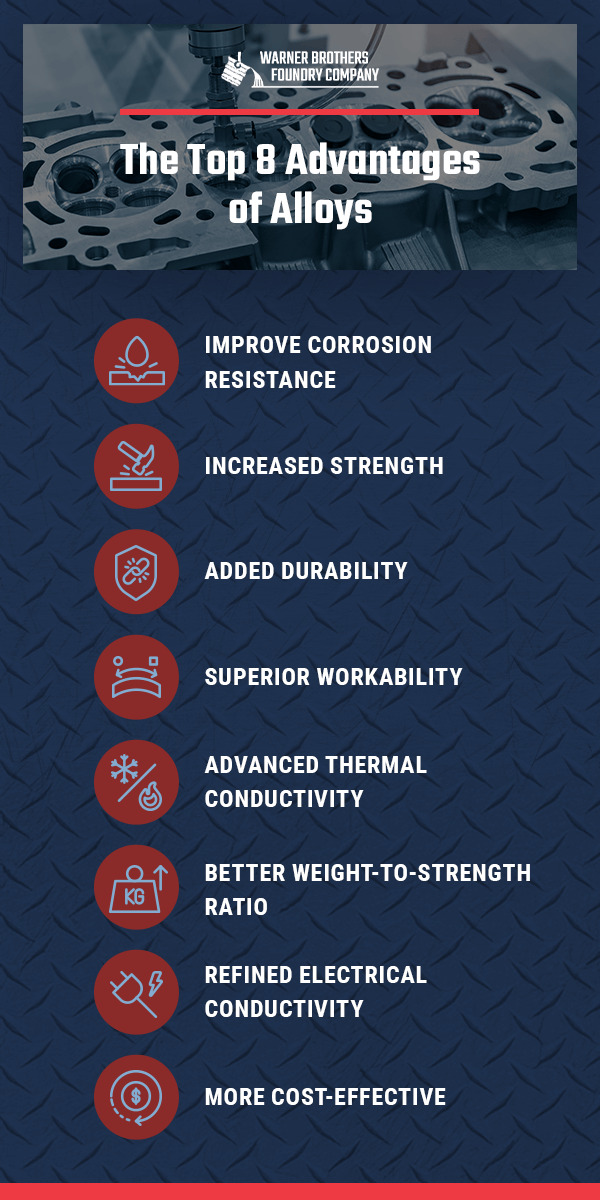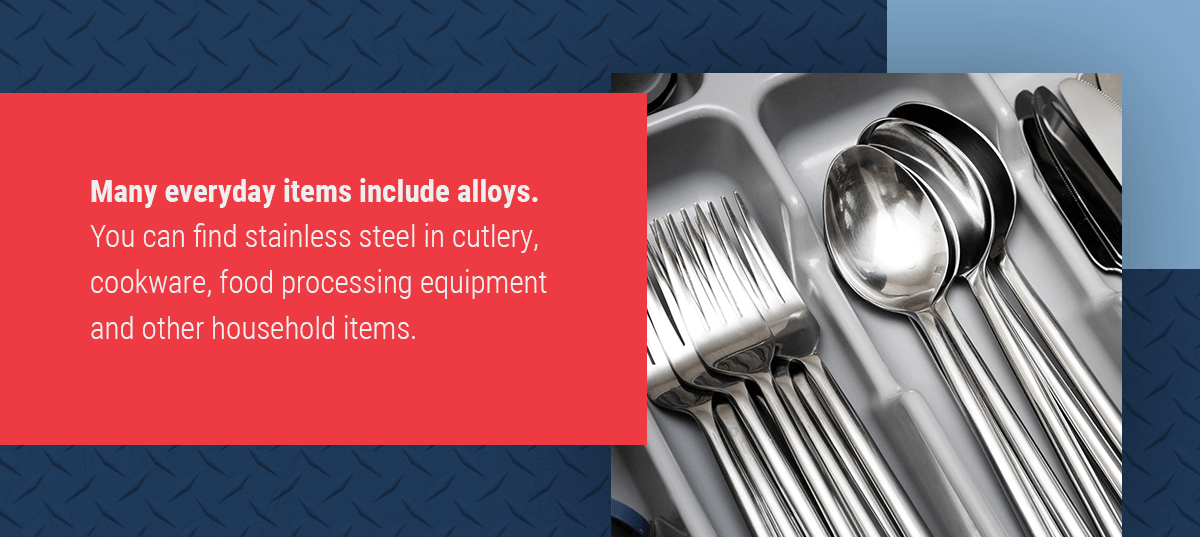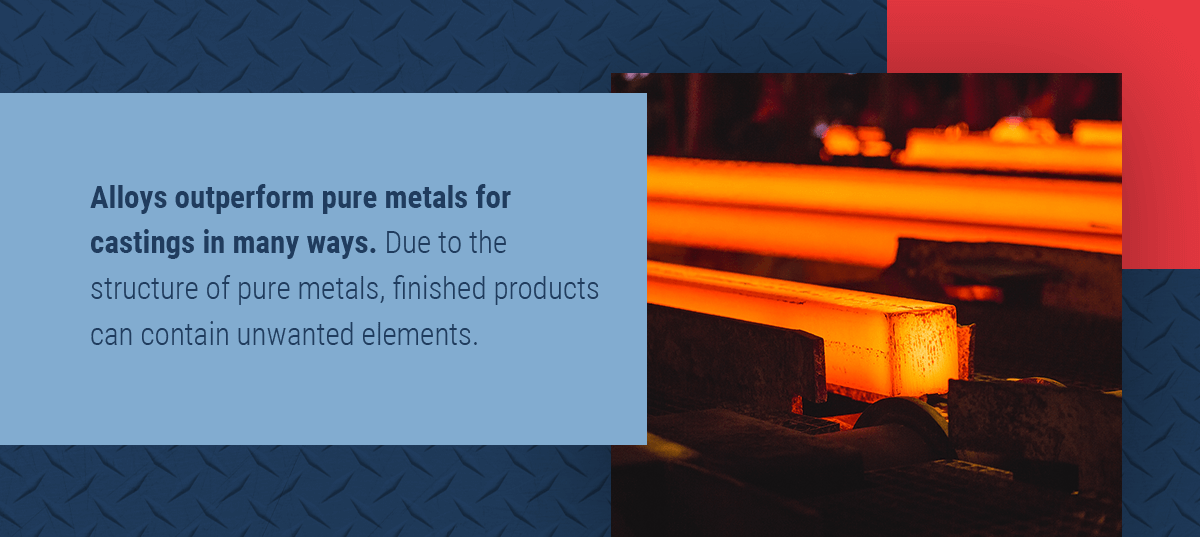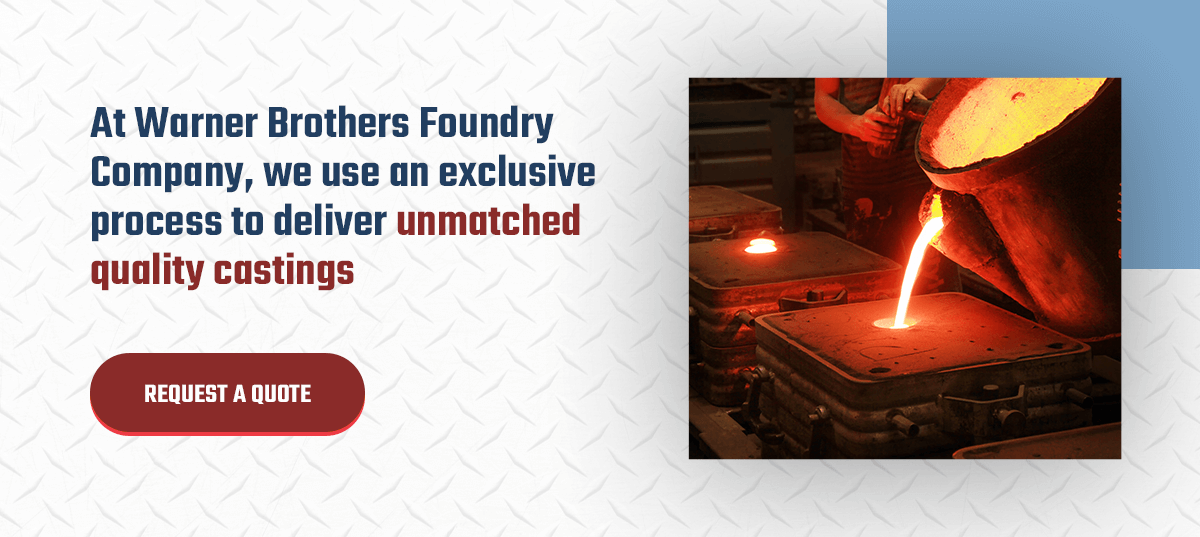
Throughout history, the development of new alloys has driven technological progress. Pure metals, while useful, have limitations — they often lack the necessary strength, durability or resistance to environmental factors for advanced applications. Alloys overcome these limitations through strategic element blending.
By choosing alloys, you have better options for castings and other metal projects than using pure metals. This guide explores the key advantages of alloys, how these materials differ in their properties and application and why they are stronger than pure metals.
What Is an Alloy?
Alloys combine two or more substances to create a product with better properties than its individual parts. Typically, alloys result from mixing metals, though non-metal alloys do exist. For instance, carbon is a non-metallic component of steel.
Properties of Alloys
Alloys’ specific properties depend on the metals used to create them. For example, when gold mixes with zinc, the resulting alloy has a gold luster but with added zinc strength. Metallurgists select the types of metals to combine into alloys based on the final product’s desired characteristics.
Alloys are more corrosion-resistant, stronger, more workable and cost less than pure metal. Factors such as composition or production methods can impact ductility, brittleness and machinability.
The Alloying Process
Alloying tailors metal properties to meet specific needs. Here is a breakdown of key aspects of the alloying process.
- Mixing and purification: Most alloys start by melting and combining two or more metals. During mixing, the metals often undergo purification to remove unwanted contaminants.
- Oxidation prevention: Various production methods protect the molten mixture from oxidation. When melted in air, slag forms on the surface that blocks oxygen from polluting the alloy beneath. Melting alloys in a vacuum also prevents oxidation.
- Additional techniques: Arc melting and induction melting are two options for creating alloys. These techniques use electricity to aid in the melting and mixing processes. Arc melting employs an electric arc to produce extreme heat, while induction uses electromagnets to heat and melt.
The Top 8 Advantages of Alloys
The characteristics of alloys offer multiple benefits over pure metals. By using alloys, you get a custom blend of metals that combines the parents’ positive attributes. Alloy products may have the following benefits over those made from pure metals:
1. Improved Corrosion Resistance
The chemically reactive nature of pure metals makes them more prone to rust. Mixing these metals with others to prevent corrosion improves their longevity. Some alloying elements are less reactive than the base metal, reducing the overall oxidation rate. Alloys often resist deterioration better than pure metals because the alloying elements form a protective surface layer. A passive oxide film prevents further corrosion. By carefully selecting alloying aspects, you can tailor the alloy’s composition to create a more stable and corrosion-resistant material compared to pure metal.
2. Increased Strength
Taking the best properties of pure metals and leaving out the less desirable ones creates a stronger structure. Compounding materials enhance the alloy’s molecular stability. The movement of atoms inside the structure of metal can affect its strength. Atoms move easily through pure metals because they are all the same shape and size. However, mixing one metal with another introduces different-sized atoms that hinder movement, making the alloys tougher.
3. Added Durability
The enhanced strength and hardness make alloys less susceptible to wear, scratching and overall damage. Alloys can withstand greater environmental stress. These factors contribute to a longer life span and improved durability compared to their pure metal counterparts.
4. Superior Workability
Workability indicates how well the materials can endure changing their shape through cold or heated methods. Some pure metals are so soft that they have good workability but low strength. Alloying these boosts strength and workability for a harder metal. For example, blending cold working with alloying makes pure tin more robust.
5. Advanced Thermal Conductivity
The thermal tolerance or melting points of pure metals change when alloyed with other materials. Pure metals have one melting point, a temperature at which their solid form turns to liquid. However, alloys have a range of temperatures that can cause changes to the material’s structure. Often, this range is higher than for individual metals. Therefore, alloys offer superior thermal stress resistance in most instances compared to pure metals.
6. Better Weight-to-Strength Ratio
For mass, alloyed metals can be less dense than pure metals while maintaining the same strength. The automotive and aerospace industries prize aluminum and titanium alloys for their lightweight strength.
7. Refined Electrical Conductivity
Conductivity determines how well the metals or alloys can transfer electrons for heat or electricity transfer. Integrating different metals can enhance or reduce heat or electricity transfer, depending on the product’s final use. For example, copper alloys offer high conductivity due to copper’s innate ability to transfer electrons well.
8. More Cost-Effective
Alloys are often less expensive than using pure metals. Alloys that combine smaller amounts of costlier pure metals with larger quantities of more affordable metals offer a less expensive solution. The alloying process can sometimes simplify manufacturing or reduce the need for expensive refining processes compared to obtaining the same properties from a pure metal.
Experts in choosing alloys and combining the metals to make them in the perfect proportions can optimize their properties for the product used.
Common Metal Alloys
Alloys include multiple types of metal combinations. Blending non-ferrous metals, which take longer to corrode, creates non-ferrous alloys that offer more strength and durability than their pure metal parents. Here are some examples of different types of alloys:
Aluminum Alloys
Aluminum appears in multiple engineering and other applications. Its low-density and lightweight nature make it a valuable manufacturing tool for parts. Popular non-ferrous aluminum alloys include:
- 713.0 aluminum alloy: This material does not require heat treatment to create strength and can work in applications that place high demands on the alloy.
- A356.0 aluminum alloy: This aluminum alloy suits automobile components such as transmission cases, rear-axle housings and oil pans. It resists hot cracking and is easy to weld.
- A206.0 aluminum alloy: Common uses for this alloy include truck spring hangers, turbines, supercharger impellers and cylinder heads.
- C355.0 aluminum alloy: This highly fluid material has a high strength at increased temperatures. It suits industrial uses like hydraulic fittings, gear housings and air-compressor fittings.
Brass and Bronze Alloys
Copper forms part of brass and bronze alloys. Brass consists of copper and zinc, while bronze uses copper and tin. The following are examples of copper-inclusive alloys:
- Composition brass: Once called red brass, this all-purpose alloy works best for castings needing moderate machinability and strength. Applications include plumbing hardware or pipe fittings.
- Manganese bronze: This high-strength alloy suits heavy-duty use except in environments that require corrosion resistance.
- Tin bronze: Various bushings, valve parts, gears, pumps, piston rings and bearings feature tin bronze.
- Aluminum bronze: Choose this alloy for the strength of manganese bronze with excellent corrosion resistance.
Titanium Alloys
Titanium alloys boast exceptional strength-to-weight ratios, excellent corrosion resistance and biocompatibility. Common applications include aerospace for aircraft structures, sporting goods and chemical processing. Their unique combination of properties makes them ideal for demanding applications.
What Are Alloys Used For?
Alloys have been around for centuries. The first alloy created was bronze, made by alloying copper and tin, giving rise to the Bronze Age around 3600 BC. Bronze improved on copper, making more durable weapons and tools. Over time, alloys have evolved to include steel, brass, aluminum and titanium. These alloys form an important part of many modern applications, such as:
Construction
Structural integrity is paramount in construction. Components that support heavy loads or form part of critical infrastructure benefit from steel alloys. Titanium alloys are part of high-performance structures like tunnels or bridges. Environments with chemical exposure may use nickel-based alloys in pipes or storage tanks.
Transportation and Aerospace
Aircraft and automobile manufacturers use aluminum alloys. For example, the aircraft industry uses 7075 Al alloy in fuselages and other structures where lighter weights and anti-corrosion are necessities.
The use of alloys in aerospace applications speaks to their undeniable strength. The industry uses aluminum, titanium, iron, copper and high-performance superalloys for their ability to resist fatigue, corrosion and high temperatures.
Electronics
Alloys are excellent conductors, making them ideal for electronics and communication devices. Common alloys used include nickel, stainless steel and brass. Alloys offer the following advantages in electronics:
- Improved conductivity: While pure metals like copper and silver are excellent conductors, alloying them can sometimes enhance specific conductivity properties or provide a better balance of properties.
- Enhanced strength and durability: Electronic components may be small and delicate, but they need to withstand handling and environmental stresses. Alloys can provide the necessary strength and durability to protect these components.
- Corrosion resistance: Many electronic devices get exposed to moisture and other corrosive elements. Alloys withstand corrosion, ensuring long-term reliability.
- Solderability: Alloys are crucial in soldering, the process of joining electronic components. Solder alloys need to have specific melting points and wetting properties to create strong, reliable connections.
- Controlled thermal expansion: Different materials expand and contract at different rates with temperature changes. Designing alloys with specific thermal expansion coefficients to match those of other components prevents stress or failure.
- Cost-effectiveness: In some cases, alloying a more expensive metal with a cheaper one can provide a cost-effective solution without significantly sacrificing performance.
Medical Devices
In the medical field, the choice of materials used in medical devices is critical. Versatile alloys offer durability, toughness, corrosion resistance and biocompatibility, making them ideal for medical equipment. Popular medical-use alloys include stainless steel, cobalt chrome, titanium and nitinol.
Medical implants, surgical tools and bone pins often use stainless steel for its non-corrosive and non-toxic properties. Lightweight, strong titanium can appear in skeletal supports, bone replacements and dental implants. Nickel-based alloys appear in everything from stents to machines that manufacture medical equipment.
Consumer Goods
Many everyday items include alloys. You can find stainless steel in cutlery, cookware, food processing equipment and other household items. Aluminum foil is a common alloy material used to wrap food. Gold, silver and platinum alloys give jewelry aesthetic appeal while increasing durability.
Musical Instruments
Consider the brass section of an orchestra. Brass, made from copper and zinc, is a primary alloy used in trombones, horns, trumpets and percussion instruments like cymbals. Electric guitars feature steel strings, while acoustic guitars often have bronze strings. Alloys contribute to the tone of these instruments.
What Is a Pure Metal?
Pure metals have no additional ingredients mixed in with them. These metals exhibit only their natural properties. However, many pure metals have undesirable attributes that make them unsuitable for industrial applications. Many pure metals, such as gold, have a uniform atomic structure, giving them a natural softness. However, by merging them with different metals, the alloys introduce new atoms that strengthen the material.
Properties of Pure Metals
Pure metals have various properties. However, many metals, such as iron, can corrode or rust. Mixing iron with other metals produces rust-resistant stainless steel.
Weight is another property of pure metals corrected by alloying. Dense metals, like gold or iron, weigh more than alloys. Fusing these with aluminum or titanium enhances strength while reducing weight. Many aerospace projects use titanium alloys for extra strength and lighter weight.
Pure Metal Examples
Pure metals appear in nature. Consider these examples of pure metals and how they enhance alloys.
- Gold: This metal can serve as a base metal in an alloy for jewelry or conductivity in electronics.
- Titanium: In materials that need added toughness, titanium boosts strength without contributing extra weight to alloys.
- Copper: One of the most widely used metals, copper offers corrosion resistance, conductivity and ductility to alloyed metals.
- Aluminum: Like titanium, aluminum is a base metal added to alloys to enhance machinability, corrosion resistance and weight reduction.
- Zinc: Often used in galvanized steel, zinc protects against corrosion.
- Tin: Cold-working applications, like spinning, rolling and extruding, use tin. It also provides corrosion protection for other metals when alloyed with them.
The above pure metals can also combine with each other or with other metals to produce alloys.
How Is an Alloy Different From a Pure Metal?
The combination of metals produces alloys with more desirable properties than those found in pure metals. Physical and chemical properties make alloys preferable for multiple industrial applications across various sectors.
- Physical properties: Alloys have different physical properties from pure metals. Alloying pure metal changes its physical properties on an atomic level to enhance it and increase the number of possible applications. The process improves mass, conductivity, workability and thermal tolerance.
- Chemical properties: The most significant difference between alloys and pure metals happens on a molecular level. The two do not have the same chemistry. Pure metals consist of atoms from a single element, like gold or iron. A process filters out the impurities of other materials from the metal. Alloys have atomic components of multiple elements, giving them a chemical structure different from pure metals.
Frequently Asked Questions
Below are answers to some common questions to further expand on the advantages of alloys over pure metals.
Why Are Alloys Stronger Than Pure Metals?
The key to alloys’ strength is their irregular atomic structure. Pure metals have a uniform, repeating arrangement of atoms, allowing layers to slide over each other and deform under stress. By mixing a base metal with other elements (metals or non-metals), alloys have different-sized atoms that disrupt this uniformity. These additional atoms, whether fitting between or replacing the base metal’s atoms, hinder the sliding of layers. The irregular pattern increases resistance to deformation and enhances strength.
Steel, an alloy of iron and carbon, exemplifies this principle. In a pure metal consisting of only iron or only carbon, the atoms would form a regular pattern. However, by combining these two elements, the smaller carbon atoms fill the gaps between the larger iron atoms. By disrupting the pattern, it makes it harder for the atomic layers to slip and deform. This blending of metals makes steel far stronger than pure iron.
Why Should We Use Alloys Instead of Pure Metals for Castings?
Alloys outperform pure metals for castings in many ways. Due to the structure of pure metals, finished products can contain unwanted elements. The metals may corrode or fail to meet the necessary strength requirements. Using pure metals may make the parts too expensive or too heavy for mass production. Alloys overcome these problems through durability, anti-corrosive properties, lighter weights, more thermal resistance and lower costs. Therefore, when choosing castings, alloys are the best option.
Determining the type of alloy is crucial in casting. The combination of metals, their proportions and the casting process impact the properties of the components created. Casting experts choose alloys based on what the end product needs to achieve. Some parts may require extra robustness, lower weight, more thermal resistance, better corrosion protection or enhanced functioning under stress.
Does Quality Control During the Casting Process Make a Difference?
Yes! The specific process used for casting makes as much of a difference in quality as the choice between using an alloy and pure metal. Pure metals have inherent problems that alloys solve. However, casting with alloys requires careful methods to ensure the integrity of the finished part. The following factors impact casting quality:
- Grain size and shape: The size and shape of grains in the material determine the quality of the casting. The process should use lower temperatures for the alloy poured into the casting and faster cooling rates to optimize the finished product. With die-casting, chilling the mold speeds up the cooling of the metal over sand casting, producing smaller grains. In some instances, adding grain refiners can also help refine the sizes of particles in the alloys.
- Phase changes: Changing the state of alloys also impacts the final product. Phase changes, such as freezing, cause inclusions to force themselves into the spaces between dendrite arms. More space between these arms negatively impacts casting quality.
- Reduced airflow: Minimizing air entry into the casting reduces porosity. Quick casting cooling can reduce air integrating into the metal. However, air still enters the part with die-casting methods. Using methods other than die-casting can reduce air contamination. Gravity-fed or low-pressure casting solves the problem of porosity and the brittleness it causes.
Discover the Benefits of Alloy Castings With Warner Brothers Foundry Company
At Warner Brothers Foundry Company, we use an exclusive process to deliver unmatched quality castings. By blending top-notch materials with our proprietary techniques, we achieve superior alloy casting results. Browse our extensive range of non-ferrous alloys or learn more about the services we provide.
Are you ready to discuss your casting requirements? Contact us today to request an obligation-free quote. Our expert team is on hand to take your next project to new heights.





